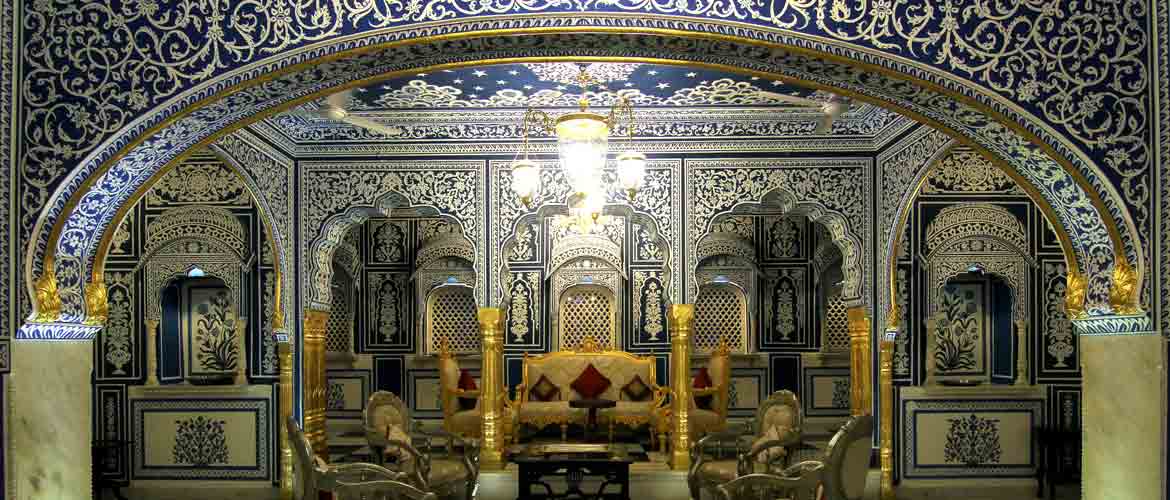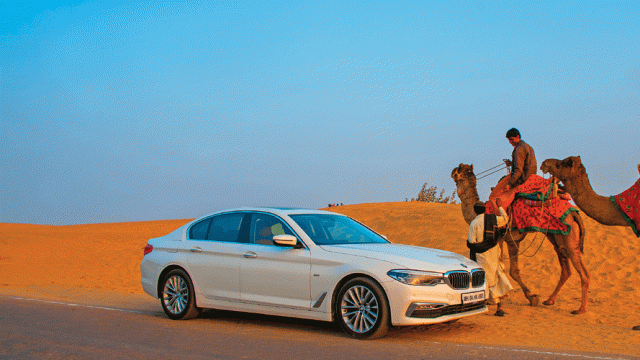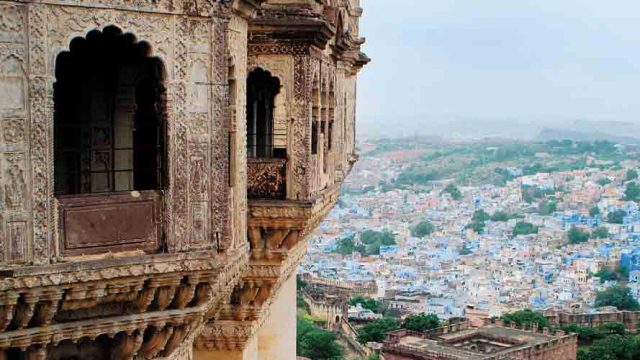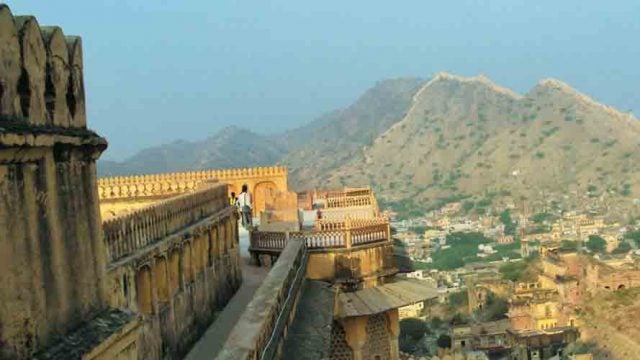Located on the corridor through which trading caravans moved freely between Delhi and the ports

Gradually, most of the merchant families – Goenkas, Poddars, Ruias, Birlas and many more – migrated to the port towns of Calcutta (now Kolkata) and Bombay (now Mumbai), slowly establishing a stranglehold over commerce between India and Britain. The tradition in those days was that whoever made it big would come back and build four things: a haveli, baoli, temple and dharamshala. With their multiplying wealth, they went on erecting colleges, cenotaphs, grander and grander havelis and – finally, when nothing else could be thought of – ordered that the havelis be painted. Tourists flock to Shekhawati to catch a glimpse of these marvellous frescos.
THINGS TO SEE AND DO
The village of Mandawa, with its cluster of hotels, is the most suitable base for exploring the region. The best of the painted towns are within a 50-km radius from here. Plus, this is as equipped as a town gets in these parts for fulfilling tourists needs. However, do keep in mind that there’s no direct rail link to Mandawa. You’ll be getting off either at Jhunjhunu, Dundlod or Nawalgarh, about a half hour ride from Mandawa. Once there, you can hire a car to take you to the surrounding towns but don’t forget to carry two essentials. First, get schematic maps of at least the major towns – such as those of Mandawa, Nawalgarh and Churu provided in The Painted Towns of Shekhawati by Ilay Cooper. Without these, it’s impossible to locate the havelis. Second, a pair of binoculars will come in handy for close-up views of murals high up on the walls, especially the erotica!
Tip Some havelis have a nominal entry fee of ₹30–100 per person. Since these are private properties, permission can be rightfully refused by the caretaker, so do respect that.


Mandawa
Mandawa came into being in 1756, when Nawal Singh built the fort that has now been turned into the hotel called Castle Mandawa (Tel: 01592-223124, 223480; Tariff: ₹7,500–24,000). Its highlight is the Gulab Rai Ladia Haveli, whose murals are exceptional, especially in the variety of their themes: scenes from the life of the owner with the fort in the background; a curly-headed Greek ‘portrait’; a woman giving birth; a couple kissing in a train compartment and another on a chair. It’s difficult to say if this erotica was at the owner’s request or an artist’s rebellion against an oppressive society, but it provides a refreshing counterpoint to the tediously ubiquitous portrayals of the unforgiving types – gods, royals and colonialists.
Bansidhar Nevatia Haveli shows the Wright brothers’ maiden flight and a European making a telephone call, as well as a rather nationalistic tug-of-war between a strongman called Prof Ramamurti and a motor car driven by an Englishman. Sneh Ram Ladia Haveli has a sitting room with a rather amateurish group portrait of rulers of various princely states. On the other hand, consider the almost photographic portraits of the merchants who owned the haveli. These were done by a man called Babu Lal who, in a rare exception, signed his works. At Murmuria Haveli, the artist attempts to set Indian themes against European backgrounds – Krishna shepherding cows in a typically English countryside, for instance. Double Goenka Haveli has amusing erotica painted on the outer left wall – a woman having sex with two men and Krishna making love to a gopi. Access to this wall is through a narrow passage from inside.
Amongst the stay options here is Desert Resort (Tel: 223245, 223514; Tariff: ₹9,000–19,000), associated with Castle Mandawa, which has a swimming pool. Hotel Mandawa Haveli (Tel: 223088; Tariff: ₹2,500–5,500), located near the Sonthaliya Gate in Mandawa, offers comfort at down-to-earth prices. Hotel Shekhawati (Tel: 223036; Tariff: ₹1,200–2,800) on the Mukundgarh Road has even lower prices, offering 25 rooms to the budget traveller.

Mahansar
A charming, laidback little town, Mahansar is the traditional business bastion of the Poddar family, which moved its flourishing business in chintz and opium here in the early 19th century. They commissioned some of the most accomplished murals in Shekhawati. Among them, the Sone ki Dukan (Golden Shop), which was actually the head office of the Poddars and was so called because of the lavish use of gold in the murals inside, is easily the piece de resistance. Whoever painted the murals was not only a consummate illustrator but also possessed a great sense of colour and composition. In particular, check out the elaborately depicted war between the armies of Rama and Ravana, Rama’s wedding and Vishnu’s incarnations.
Nearby is the Mahansar Fort, founded by Thakur Nahar Singh in 1768. A portion of it has been turned into a heritage hotel called Narayan Niwas Palace (Tel: 01595-264322; Tariff: ₹1,600–2,250).
Location 28km north of Mandawa
Nawalgarh
Most of the havelis in Nawalgarh are now in a state of disrepair, the only exception being the Poddar Haveli, which has been turned into a museum. The murals in this early 20th-century haveli have been carefully restored to their original glory. The museum also exhibits wedding costumes of different communities of Rajasthan.
In terms of artistic brilliance, the painted ceiling of a small room in the fort called Bala Qila stands out. The small room, studded profusely with mirrors, is circular. And the murals, lustrous and colouful, depict an artist’s impression of the cities and armies of Jaipur and Nawalgarh in the 1850s. It costs ₹10 to enter.
Stay in Nawalgarh at Hotel Roop Niwas Kothi (Tel: 01594-224152; Tariff: ₹5,000–12,000), a sprawling mansion inspired by Italian originals. It has well-kept gardens and also arranges horse safaris.
Location 28km southeast of Mandawa
Tip It would not be wise to go without bookings in the tourist season (October– February).
WHERE TO EAT
Most restaurants in Shekhawati serve banal Mughalised fare. If you are looking for authentic Rajasthani cuisine, you will have to make a special request to the cook. You can dine at most of the hotels mentioned here after making reservations.
FAST FACTS
When to go The Shekhawati region can boast the hottest summers and coldest winters of the northern plains, which should make the travelling seasons obvious. The winter nights are, therefore, bone chilling while the days are pleasant
Tourist Office
RTDC
Bikaner House, Pandara Road, New Delhi. Tel: 011-23389525, 23383837
W rajasthantourismindia.com
STD codes Mandawa and Bagar 01592 Mahansar 01595 Nawalgarh 01594
GETTING THERE
Air Nearest airport: Sanganer, Jaipur (183km/ 3.5hrs), connected daily to all the metros. A taxi will charge you ₹8–10 per km to Mandawa
Rail Nearest railhead for Mandawa: Churu (55km/ 1hr). Bikaner Intercity connects Delhi to Churu
Road Shekhawati lies within the angle formed by NH48, NH52 and NH11, which connect Delhi to Jaipur and Jaipur to Bikaner, respectively. Take NH9 (Rohtak Road) to Bahadurgarh, then NH334B to Loharu, via Jhajjar and Charkhi Dadri. From here, district roads lead to Mandawa, Surajgarh, Bagar and Jhunjhunu
Read more in the new Outlook Traveller Getaways Heritage Holidays in India
heritage
fresco paintings
culture





